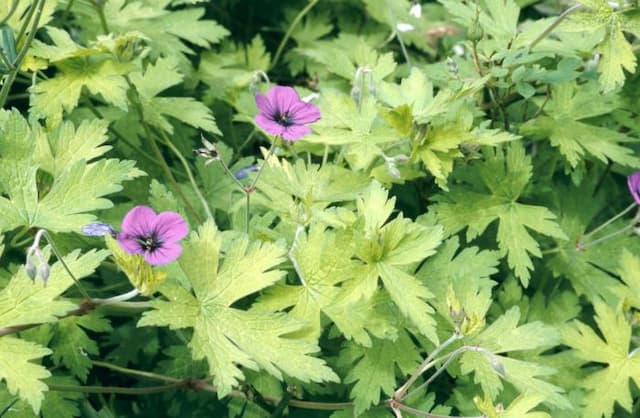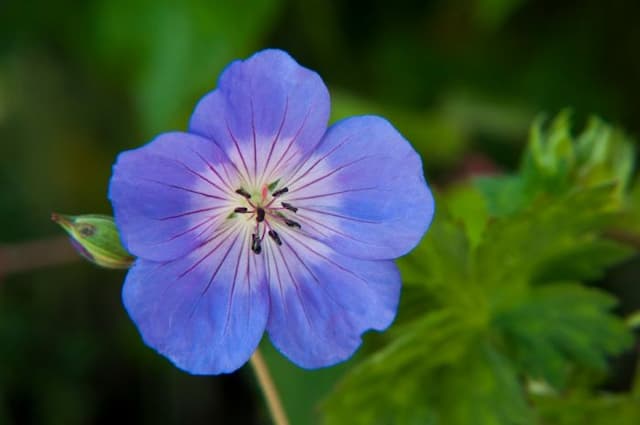Meadow Cranesbill Geranium pratense 'Mrs Kendall Clark'

ABOUT
Geranium pratense 'Mrs Kendall Clark', commonly known as meadow cranesbill, is a perennial plant recognized for its distinct ornamental qualities. This variety boasts a bushy, clump-forming habit with rounded, deeply lobed leaves that are lush green in color, giving it a full and textured foliage display. Throughout the blooming season, 'Mrs Kendall Clark' produces striking flowers. These blossoms are a delicate pale blue hue, veined with darker blue lines, and they have white centers that add depth to their appearance. The flowers are cup-shaped with five rounded petals, and they grow in loose clusters that enhance the plant's overall aesthetic appeal. This particular cultivar is sought after for its extended blooming period and the way its flowers gracefully rise above the foliage on slender stems, giving the impression of a soft blue cloud when viewed from a distance. The plant's foliage may also take on reddish tones in the autumn, adding another layer of visual interest as the seasons change. Overall, 'Mrs Kendall Clark' provides a touch of elegance to garden borders and beds with its enchanting flowers and lush, green leaves.
About this plant
 Names
NamesFamily
Geraniaceae.
Synonyms
Meadow Cranesbill, Mrs Kendall Clark Geranium.
Common names
Geranium pratense 'Mrs Kendall Clark'.
 Toxicity
ToxicityTo humans
The meadow cranesbill, as Geranium pratense 'Mrs Kendall Clark' is more commonly known, is generally considered non-toxic to humans. Ingesting any part of this plant is not expected to cause serious health issues. However, it is important to note that even non-toxic plants can sometimes cause mild discomfort or allergic reactions in sensitive individuals if ingested or handled.
To pets
The meadow cranesbill is also considered non-toxic to pets. However, as with humans, ingestion of any part of the plant might lead to mild gastrointestinal upset in some animals. It is always best to keep an eye on your pets and prevent them from eating large amounts of any non-food plants, as individual reactions can vary.
 Characteristics
CharacteristicsLife cycle
Perennials
Foliage type
Deciduous
Color of leaves
Green
Flower color
Blue
Height
2-3 feet (60-90 cm)
Spread
2-3 feet (60-90 cm)
Plant type
Herb
Hardiness zones
5
Native area
Europe
Benefits
 General Benefits
General Benefits- Attractive Flowers: The plant features beautiful pale blue flowers that add aesthetic appeal to gardens and landscapes.
- Pollinator Friendly: It attracts bees and butterflies, promoting biodiversity and benefiting the local ecosystem.
- Drought Tolerant: Once established, it can tolerate periods of dry weather, making it suitable for low-water gardens.
- Border Planting: Its stature and flowering habit make it ideal for borders and edges in garden design.
- Cottage Garden Appeal: The plant contributes to a traditional cottage garden look with its informal growth and charming flowers.
- Easy to Grow: This geranium variety is known for being easy to cultivate and low maintenance, requiring minimal care once established.
- Seasonal Interest: It offers seasonal interest from early to mid-summer with its blooms.
 Medical Properties
Medical PropertiesThis plant is not used for medical purposes.
 Air-purifying Qualities
Air-purifying QualitiesThis plant is not specifically known for air purifying qualities.
 Other Uses
Other Uses- Photography: The striking blue flowers of Geranium pratense can be used as a subject or backdrop in macro photography to capture the intricate details or enhance the aesthetic appeal of garden photographs.
- Artistic Inspiration: Artists may use Geranium pratense as a muse for painting, drawing, or sketching due to its attractive flowers and foliage which can offer a unique addition to botanical art collections.
- Dye Production: The petals of Geranium pratense can be used to produce a natural dye for textiles, giving fabrics a subtle blue or violet hue.
- Eco-Printing: Leaves and flowers of this plant can be used in eco-printing, a technique where plant materials are used to create prints on paper or fabric, often resulting in interesting and unexpected patterns.
- Fragrance Source: While not commonly known for its scent, the leaves can sometimes be used for their subtle fragrance in potpourris or as a freshener when placed in drawers or closets.
- Educational Tool: Schools and educational institutions can use Geranium pratense in botany classes to teach students about plant biology, pollination, and the lifecycle of perennial plants.
- Garden Theme Creation: They can be used to create a 'moon garden' where plants with pale-colored flowers illuminate the landscape under the moonlight, offering a magical nighttime scene.
- Culinary Garnish: The edible flowers can be used as an ornamental edible garnish for salads, desserts, and specialty cocktails, adding a touch of elegance and subtle flavor.
- Butterfly Garden: Geranium pratense attracts butterflies and can be planted specifically to create butterfly gardens, providing a habitat that supports the lifecycle of these pollinators.
- Craft Projects: Dried flowers and seed pods can be used in craft projects, such as creating wreaths, bookmarks, or pressed flower arrangements for decorative purposes.
Interesting Facts
 Feng Shui
Feng ShuiThe Geranium is not used in Feng Shui practice.
 Zodiac Sign Compitability
Zodiac Sign CompitabilityThe Geranium is not used in astrology practice.
 Plant Symbolism
Plant Symbolism- Unity and True Friendship: Geraniums are often associated with unity and strong bonds between friends, symbolizing deep connections and trust.
- Good Health: The geranium is sometimes used as a symbol for good health and positive energy, radiating a sense of well-being.
- Stability and Grounding: Due to the sturdy nature of the plant, geraniums can represent stability and the importance of staying grounded in difficult situations.
- Ingenuity: The diverse and adaptable character of Geraniums signifies ingenuity and the ability to thrive in various circumstances.
- Fertility and New Life: In some cultures, geraniums are seen as a symbol of fertility and renewal, often used in ceremonies to celebrate new beginnings.
 Water
WaterThe meadow cranesbill, also known as Geranium pratense 'Mrs Kendall Clark', should be watered deeply and thoroughly, ensuring that the soil is moist but not soaked. During the growing season, it's generally recommended to water once a week with about 1 to 1.5 gallons per plant, depending on the weather conditions and soil type. In periods of drought or extreme heat, you might need to water more frequently. It's important not to let the soil dry out completely, but also to avoid waterlogging as this could lead to root rot.
 Light
LightThe meadow cranesbill thrives best in full sun to partial shade. It should be placed in a location where it can receive at least four to six hours of sunlight per day. Morning sun with afternoon shade is ideal to protect the plant from the strong midday sun, especially in hotter climates.
 Temperature
TemperatureThe meadow cranesbill is a hardy perennial that can withstand temperatures down to around 5°F, which covers most temperate regions. It grows best at temperatures between 60°F and 75°F. However, it's important to note that it should be protected from harsh frost which can damage the plant.
 Pruning
PruningMeadow cranesbill should be pruned to remove dead leaves and spent flowers to encourage new growth and additional blooms. The best time to prune is after the first flowering, cutting the plant back by half to stimulate a second flush of blooms. Light pruning can also be done throughout the growing season to shape the plant and maintain its appearance.
 Cleaning
CleaningAs needed
 Soil
SoilThe Meadow Cranesbill 'Mrs Kendall Clark' performs best in a soil mix that is fertile, moist, and well-draining. A loamy soil amended with organic matter such as compost or peat is ideal. The optimal pH range for this plant is between 5.8 and 6.8.
 Repotting
RepottingMeadow Cranesbill 'Mrs Kendall Clark' should be repotted every 2-3 years to refresh the soil and to accommodate growth. Division of the plant during repotting helps to maintain its vigor.
 Humidity & Misting
Humidity & MistingMeadow Cranesbill 'Mrs Kendall Clark' thrives in average garden humidity levels and does not require any special humidity adjustments.
 Suitable locations
Suitable locationsIndoor
For indoors, use bright, indirect light and well-draining soil.
Outdoor
Plant in part sun to full sun with moist soil.
Hardiness zone
4-8 USDA
 Life cycle
Life cycleThe life cycle of Geranium pratense 'Mrs Kendall Clark,' commonly known as Meadow Cranesbill, begins with seed germination, which typically occurs in early spring when temperatures allow. The plant emerges as a seedling with its first true leaves, after which it enters a vegetative growth phase developing a rosette of deeply cut leaves. As it matures, the stem elongates, and flower buds develop, leading to the blooming stage in late spring to early summer, revealing delicate pale blue flowers with prominent veins. After pollination, typically by bees, the plant sets seed in unique beak-shaped pods through the summer. The seeds are dispersed by wind or animals when the pods ripen and burst open, closing the reproductive phase. Finally, as a perennial, the Meadow Cranesbill enters a period of dormancy in the fall, with the above-ground foliage dying back and the plant relying on its root system to survive the winter before the cycle begins anew.
 Propogation
PropogationPropogation time
Spring to Summer
The most popular method of propagating Geranium pratense 'Mrs Kendall Clark', commonly known as Meadow Cranesbill, is by division. This should ideally be done in the spring or fall when the plant is not in active bloom. To propagate by division, gently lift the plant from the soil, making sure to keep a substantial amount of the root system intact. Using a sharp spade or knife, divide the plant into smaller sections, each with several shoots and a healthy portion of roots. Replant the divisions at the same depth they were growing at previously, spacing them about 12 inches (approximately 30 centimeters) apart to allow enough room for growth. Water the new plants thoroughly to help establish them. This method promotes a quicker establishment compared to starting from seed and can rejuvenate older clumps that may have become woody or less vigorous.









